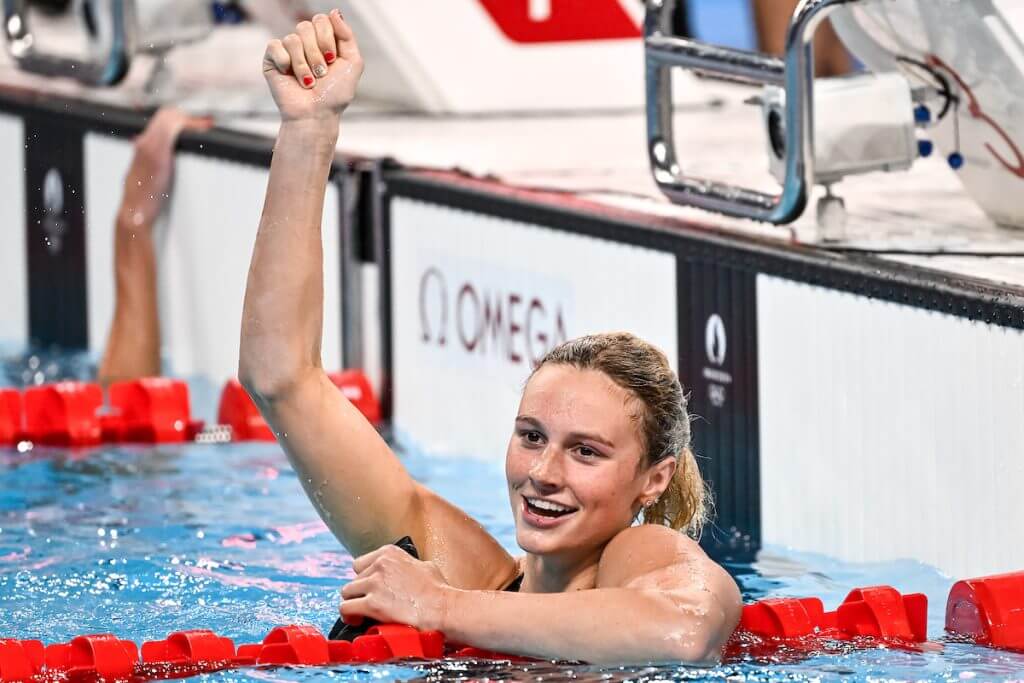How Olympians Raced the 200-Meter Events: Analyzing Strategies of Success in Paris

How Olympians Raced the 200-Meter Events: Analyzing Strategies of Success in Paris
“Go out as fast as possible. Don’t hold back!”
“Build the first 100, and then stay strong.”
“Keep a consistent pace!”
These are all strategies which have guided the ways athletes race the 200 freestyle, an event that can be persplexing. The distance has been a debate for years in the swimming community. Its place between the traditional “sprint” of a 50 or 100 and the “distance” of a 400 and above has frustrated swimmers for decades. But with so many different philosophies on how to swim the event, I sought to find an answer. Is there truly a best way to swim any of the 200s?. Utilizing data from the 2024 Olympic Games, I found some interesting trends, ones which helped provide an answer to this sought-after question.
Get Out to a Fast Start
A key factor which immediately stood out in my research was the impact of the first 50 of a race for Olympians. Some swimmers often preach the idea of “setting the tone” in this 50. These competitors look to go out quickly and maintain their speed. Others, however, look to build the race into the fastest pace they can handle. The data points to a balance between the two strategies are crucial, and vary heavily by race.
In the 200s of butterfly and breaststroke at the Paris Games, the fastest swimmers tended to get out to a stronger start than in freestyle and backstroke. All but two swimmers in the finals of the men’s and women’s 200s Breast and Fly saw at least a three-second difference between their first and second splits, not seen in either of the other 200s.
But what makes short-axis strokes like butterfly and breaststroke so different from the long-axis strokes of backstroke and freestyle? The answer seems to be the overall stress of the stroke. Swimmers are able to maintain front-half speed much easier in freestyle and backstroke, whereas their efficiency slows in breaststroke and butterfly as the race wears on. The ability to hold an aerobic pace seems to be more difficult in these shorter-axis strokes.
Specifically, the final of the women’s 200 freestyle represented a big outlier in the data. Only four of the swimmers within this final saw at least a two-second difference between their first and second splits, suggesting impressive consistency.
I found most interesting that the men’s 200 freestyle wasn’t similarly consistent, with six swimmers seeing more than a two-second difference in their opening splits. After analyzing the race and the splits, the men’s race featured greater variance in racing approaches. This fact produced a more spread out field after the opening 50 meters of the four-lap race. In the women’s race, the seeding of favorites Mollie O’Callaghan, Arianne Titmus, and Siobhan Haughey placed them in the middle of the pool, with the rest of the field attempting to keep pace. In the men’s 200 freestyle, however, there wasn’t a clear favorite, and the field seemed to go with their own strategies, rather than trying to remain with a specific frontrunner.
Keeping Consistent Pace
Another strategy coaches and swimmers often emphasize is “trying to set a pace” in a 200. This requires consistency from the swimmer, which can come in a variety of ways. I set out to analyze this approach by finding the average difference between splits of each swimmer within each of the 200 finals. I then sought out whether or not the winningest swimmers were able to be more consistent than their competitors.
Six of the eight gold medalists in the 200 distances had a lower average difference between splits than the average across the field, along with 16 of the 24 medalists. The more consistent swimmers rose to the occasion at a 75% clip, showcasing the importance of being able to hold one’s pace for all four laps of the race.
Swimmers achieved this success in a variety of ways, but one I found most interesting was stroke rate. For example, in Australian star Kaylee McKeown’s 200 backstroke, she took 17, 18, 20 and 20 strokes per lap, remarkably close numbers for a four-lap race.
McKeown’s consistent stroke rate allowed her to hold a standout 0.89 average difference. She was also aided by unchanging underwaters, kicking to about 11 meters on every lap. Repetition of the same habits across all four laps made for a reliable pace and a gold medal finish.
“The Third 50”
In any discussion of swimming a 200, the importance of the third 50 will always find its way into the debate. This leg is often seen as the most important, as swimmers attempt to hold their speed over the latter half of the race. But could this 50 truly be the difference in a race of magnitude? I found the third 50 of each swimmer in the Olympic finals of these 200s to determine the answer. Five of the eight gold medalists had the fastest third 50 in their races. All eight swimmers with the fastest third 50 earned a medal. The world’s fastest swimmers emphasized this leg as an important turning point in the race.
In the women’s 200 butterfly, Summer McIntosh outsplit competitors Zhang Yufei and Regan Smith by almost a second on the third 50, blasting in front of what was a tight race.
The sample size used in this analysis was small, but using information from the 2024 Olympics was informing about how to swim a 200. At least for Paris, the importance of “going out fast or slow” depended on the race and stroke. However, the importance of consistent pacing and strong third 50s proved consistently necessary.
The above analysis does not advocate for a specific way to swim races. Rather, this piece is designed to present the different approaches that were utilized at the most recent Olympic Games and how these approaches factored into the medals distribution.

- EVENT PAGE
- SCHEDULE
- VENUE
- STREAMING INFO
- DAY 1 PRELIMS RESULTS
- DAY 1 FINALS RESULTS
- DAY 2 PRELIMS RESULTS
- DAY 2 FINALS RESULTS
- DAY 3 PRELIMS RESULTS
- DAY 3 FINALS RESULTS
- DAY 4 PRELIMS RESULTS
- DAY 4 FINALS RESULTS
- DAY 5 PRELIMS RESULTS
- DAY 5 FINALS RESULTS
- DAY 6 PRELIMS RESULTS
- DAY 6 FINALS RESULTS
- DAY 7 PRELIMS RESULTS
- DAY 7 FINALS RESULTS
- DAY 8 PRELIMS RESULTS
- DAY 8 FINALS RESULTS
- DAY 9 FINALS RESULTS




regarding the difference between the 1st and 2nd 50 in breast and fly vs back and free probably has to do with breast and fly diving in and going to a hand touch vs diving in and going to a foot touch on back and free. Not a difference in race strategy